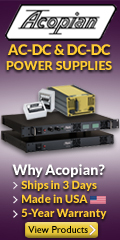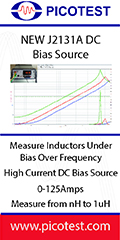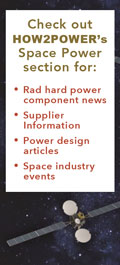 |
|
IN THIS ISSUE:
» Increasing Power Density In Three-Phase Inverters With Direct-Cooled SiC Power Modules
» Improving Reliability Of Low-Cost Power-Source Inverters
» Avoiding Thermal Runaway In Schottkys Is Key To More Reliable And Efficient Designs
» The Engineer’s Guide To EMI In DC-DC Converters (Part 15): Differential-Mode Input Filter Design
» Focus On Magnetics:
Foil Vs. Wire Windings—How Do They Differ?
» Spotlight On Safety & Compliance:
Materials Compliance: Avoiding Product Recalls With Platform Technology
» New Power Products
» Industry Events:
- Workshop On Integrated Power Packaging Invites Paper Submissions
- ECCE 2020 Concludes Successful Virtual Event
» Other Top Power News
From the Editor's Desk David G. Morrison
Editor, HOW2POWER TODAY

Sales of electric vehicles (EVs) are still at modest levels. According to the International Energy Agency’s (IEA) “Global EV Outlook 2020” tech report, EVs accounted for just 2.6% of worldwide car sales in 2019 which equates to approximately 2.1 million EVs sold last year. However, looking back at EV sales over the past decade we see that this figure represents tremendous growth. According to the IEA report, there were only 17,000 EVs being driven in 2010, but by last year that tally had reached 7.2 million. The report discusses the policies, and technology and consumer trends, which are expected to drive further EV growth in the coming decade. According to one scenario, the global EV stock could reach 140 million vehicles in 2030, while another projection has it growing to 245 million vehicles. This is just one important segment of the electrification trend affecting vehicles and heavy equipment of all kinds. Because inverters are at the heart of these applications, we can expect the power electronics industry will be driven to devote significant attention to inverter development in the years ahead. Some of these improvements will be achieved in packaging as demonstrated by a feature this month by Matthew Feurtado and colleagues describing the gains in power density in three-phase inverters that can be achieved by implementing liquid cooling more effectively in SiC power modules. Another article in this issue by Dennis Feucht suggests that EV traction inverters aren’t the only inverters needing development as he discusses reliability issues in low-cost power inverters. This newsletter also brings further discussion of EMI filter design, foil versus wire windings, and the benefits of platform data technology for materials compliance, plus the latest power component news and more.
|
|

 |
 |

|
HOW2POWER EXCLUSIVE DESIGN ARTICLES 
|
Increasing Power Density In Three-Phase Inverters With Direct-Cooled SiC Power Modules
by Matthew Feurtado, Matt Reeves, Daniel Martin, and Ty McNutt, Wolfspeed, Fayetteville, Ark. and Wieland Microcool, Bend, Ore.
Wolfspeed has developed a next-generation module that has been highly optimized to achieve the maximum performance out of Wolfspeed Generation 3 SiC MOSFETs. The XM3 half-bridge power modules offer the capability to carry high currents (300 to >600 A) in a small footprint (53 mm x 80 mm). Due to the high current density of SiC power devices the thermal performance of the module and cold plate is critical to maximizing heat flux and reducing system size and cost. The XM3 modules are offered in both a conventional flat baseplate version, which mounts to a liquid-cooled heatsink, and a direct-cooled baseplate which essentially integrates liquid cooling within the baseplate. In this article, the characteristics of both module types are described and the performance and manufacturing benefits of the direct-cooled modules are explained and demonstrated.
Read the article…
|

A direct-cooled module replaces the flat
copper baseplate with a copper pin-fin
baseplate where the pins are designed to
be in direct contact with a coolant. |

|

The typical two-stage architecture
used in inverters developed for the
consumer market. |
Improving Reliability Of Low-Cost Power-Source Inverters
by Dennis Feucht, Innovatia Laboratories, Cayo, Belize
In hardware and automotive stores you can find inverters that supply 120 V ac rms from your vehicle’s 12-V battery bus. Various brands exist at various power outputs. The consumer market is flooded with such low-cost inverters. Many of these inverters have one characteristic in common. To be price competitive, they have cut corners in the design, resulting in unreliable products. Engineers and others with electronics knowledge may be tempted to repair these products when they fail, and may even want to make upgrades to improve their reliability. However, the manufacturers do not support either of these activities. In this article, the author examines some inverter product examples, discusses why they are unreliable, and proposes some possible solutions with the ultimate goal of enabling more robust low-cost inverter designs.
Read the article…
|

Avoiding Thermal Runaway In Schottkys Is Key To More Reliable And Efficient Designs
by Jos van Loo, Taiwan Semiconductor Europe, Zorneding, Germany and Kevin Parmenter, Taiwan Semiconductor America, Chandler, Ariz.
Schottky diodes are used more and more in applications where there is a combination of high ambient temperatures and higher voltages present. This means it is time to revisit thermal runaway in Schottky diodes. By better understanding how the maximum Tj of a Schottky diode is defined and why thermal runaway happens, design engineers will be able to build more efficient and more reliable products. This article looks at the factors that lead to thermal runaway and describes its two forms—static and dynamic. It also discusses the importance of reliability testing and thermal modeling in avoiding thermal runaway. Much of this discussion revolves around a Schottky rectifier’s forward voltage and leakage current specifications, how they influence thermal performance, junction temperatures, reliability, efficiency, and aspects of Schottky device structure that influence these two specifications.
Read the article…
|

If a Schottky is switched from on
to off at a higher temperature and
the reverse losses are higher than
the forward losses, the junction
temperature may drift upward
resulting in thermal runaway. |

|

This DM equivalent current source
and LISN circuit for DM noise
measurement are derived from a
typical CISPR 25 CE measurement
setup for a buck converter with
input π-filter and LISN circuit
connected on each supply line. |
The Engineer’s Guide To EMI In DC-DC Converters (Part 15): Differential-Mode Input Filter Design
by Timothy Hegarty, Texas Instruments, Phoenix, Ariz.
Due to their high efficiency, small solution size and low component count, you’ll find modern dc-dc converters in almost all electronic systems in the automotive, communications infrastructure, enterprise/data center and industrial sectors. Yet these converters generate substantial conducted electromagnetic interference (EMI), both differential mode (DM) and common mode (CM), as a side effect of high-frequency and high-edge-rate switching. This article reviews theoretical concepts related to input filter design to minimize DM noise specifically, including selecting the filter topology, estimating the required filter attenuation and calculating the filter component values. A simulation provides the expected attenuation based on an input filter for conducted emissions from an automotive synchronous buck converter.
Read the article…
|


FOCUS ON MAGNETICS 
Sponsored by Payton Planar Magnetics
A monthly column presenting information on power magnetics design, products, or related technology |

Foil Vs. Wire Windings—How Do They Differ?
by Dennis Feucht, Innovatia Laboratories, Cayo, Belize
The two most common conductor shapes for windings are round wire and flat foil. This article assesses the merits of round wire and foil in winding magnetic components. Four comparisons are made to describe the impact of conductor shape on winding loss, with three involving eddy-current resistance. The article begins by comparing foil windings with round and square windings in terms of their effect on packing factor. Next it looks at how wire geometry affects the penetration ratio and winding resistance ratios used in Dowell’s equations, and then goes further to explore 1D and 2D skin resistance effects. Finally, Dowell’s curves are generated to show how winding resistance due to eddy current effects varies with wire thickness and number of layers.
Read the full article…
|

 |
 |

SPOTLIGHT ON SAFETY & COMPLIANCE 
Sponsored by Power Integrations
A monthly column discussing standards and regulatory requirements affecting power electronics |

Materials Compliance: Avoiding Product Recalls With Platform Technology
by Valerie Kuntz and Neil Smith, Assent Compliance, Ottawa, Ontario
“The electronics industry is famous for jumping into the latest societal crisis, imposing new regulations. This has progressed to where OEMs must make materials declarations for every component in their products as to their compliance with RoHS, WEEE, REACH and California prop 65— to name a few. Disclosure requirements are manifold and penalties are severe,” says Safety & Compliance columnist Kevin Parmenter. “This has created a tsunami of customer requests for information from their component manufacturers, distributors and others. Keeping up with the requests can be overwhelming for both the suppliers and their customers. In this S&C column, Valerie Kuntz and Neil Smith explain how platform data technology offers relief from the compliance tracking and reporting burden, enabling companies to manage changing materials compliance requirements in an orderly fashion.”
Read the full article…
|

 |
 |

 |
|
|

 — POWER PRODUCTS IN 3 IMAGES OR LESS — POWER PRODUCTS IN 3 IMAGES OR LESS 
|


AESIM.Tech’s SIMBA power
electronics simulation software. |
Power Electronics Simulation Software Is Fast, Powerful And Easy To Use
 Screenshot: In developing this product, the company’s ambition is to create a platform simple enough for students and hobbyists but sufficiently fast and powerful for most complicated use cases. Even large converters such as this five-level NPC power converter are simulated quasi-instantaneously. Screenshot: In developing this product, the company’s ambition is to create a platform simple enough for students and hobbyists but sufficiently fast and powerful for most complicated use cases. Even large converters such as this five-level NPC power converter are simulated quasi-instantaneously.
 Screenshot: The SIMBA Predictive Time-Step solver simulates complex systems without compromising the accuracy. Screenshot: The SIMBA Predictive Time-Step solver simulates complex systems without compromising the accuracy.
See the full story…
|


 |

|


Power Integrations’ LYT6078C
LED driver IC. |
Efficient GaN-Powered LED Drivers Target Smart-Lighting Designs
 Drawing: By incorporating a 750-V GaN power switch, the LYT6078C increases the power output capability of the LYTSwitch-6 LED driver versus what the original members of the family could deliver using a silicon MOSFET, while also offering a higher breakdown voltage for those looking to operate from a commercial 277-Vac source or poorly regulated power grids. Drawing: By incorporating a 750-V GaN power switch, the LYT6078C increases the power output capability of the LYTSwitch-6 LED driver versus what the original members of the family could deliver using a silicon MOSFET, while also offering a higher breakdown voltage for those looking to operate from a commercial 277-Vac source or poorly regulated power grids.
See the full story…
|

Renesas Electronics’ ISL9122A
buck-boost regulator. |
Buck-Boost Converter With Ultra-Low Quiescent Current Powers Sensors And Other Devices
 Diagram: This flexible buck-boost switching regulator with bypass mode extends battery life for wireless and smart IoT devices. Quiescent current is 1300 nA in regulation mode, 120 nA in forced bypass mode and 8 nA in shutdown mode. Diagram: This flexible buck-boost switching regulator with bypass mode extends battery life for wireless and smart IoT devices. Quiescent current is 1300 nA in regulation mode, 120 nA in forced bypass mode and 8 nA in shutdown mode.
 Graph: Because of its adaptive frequency hysteretic control, the regulator provides excellent efficiency. Graph: Because of its adaptive frequency hysteretic control, the regulator provides excellent efficiency.
See the full story…
|


EPC Space’s rad hard GaN
power transistors. |
Rad Hard GaN Power Transistors Span 40 V To 300 V
 Table: This family of rad hard enhancement-mode power transistors span a range of 40 V to 300 V, and 4 A to 30 A. According to the company, these GaN devices are smaller, have lower resistance, and have many times superior switching performance compared to rad hard silicon MOSFETs. Table: This family of rad hard enhancement-mode power transistors span a range of 40 V to 300 V, and 4 A to 30 A. According to the company, these GaN devices are smaller, have lower resistance, and have many times superior switching performance compared to rad hard silicon MOSFETs.
See the full story…
|


|










|

INDUSTRY EVENTS  |
|
Workshop On Integrated Power Packaging Invites Paper Submissions
IWIPP 2021, a PSMA and IEEE sponsored workshop, will be held April 28 to 30, 2021, on the beautiful campus of Aalborg University in Denmark. Under the leadership of general chairman Francesco Iannuzzo, the International Workshop on Integrated Power Packaging brings together industry, academic and government researchers in the field of power electronics components, electrical insulating materials, and packaging technologies to facilitate and promote the development and commercialization of high-density and high-efficiency power converters. Read the full story…
|
|
ECCE 2020 Concludes Successful Virtual Event
Today is the final day of the IEEE Energy Conversion Congress & Exposition (ECCE 2020), which was held virtually this year. The conference featured 959 technical papers spread across 62 oral sessions and 36 digital poster sessions, plus 20 special sessions and 14 tutorials. If you missed the conference live this week, most sessions will be available on-demand until November 16. See the website for details on virtual registration. Note that the virtual format also provides free access to the plenary talks and other select sessions including the awards ceremony, plus sponsor presentations and exhibits. See the website.
|

 The joint sponsors of APEC have announced the continuation of the popular Student Attendance Travel Support Program. The joint sponsors of APEC have announced the continuation of the popular Student Attendance Travel Support Program.

ABOUT THIS NEWSLETTER: Thank you for reading HOW2POWER TODAY.
How2Power sends no more than one e-mail per month to registered users. Continuing your subscription ensures you'll receive future newsletters. Manage Your Subscription
©2020 All rights reserved. www.how2power.com
|
|